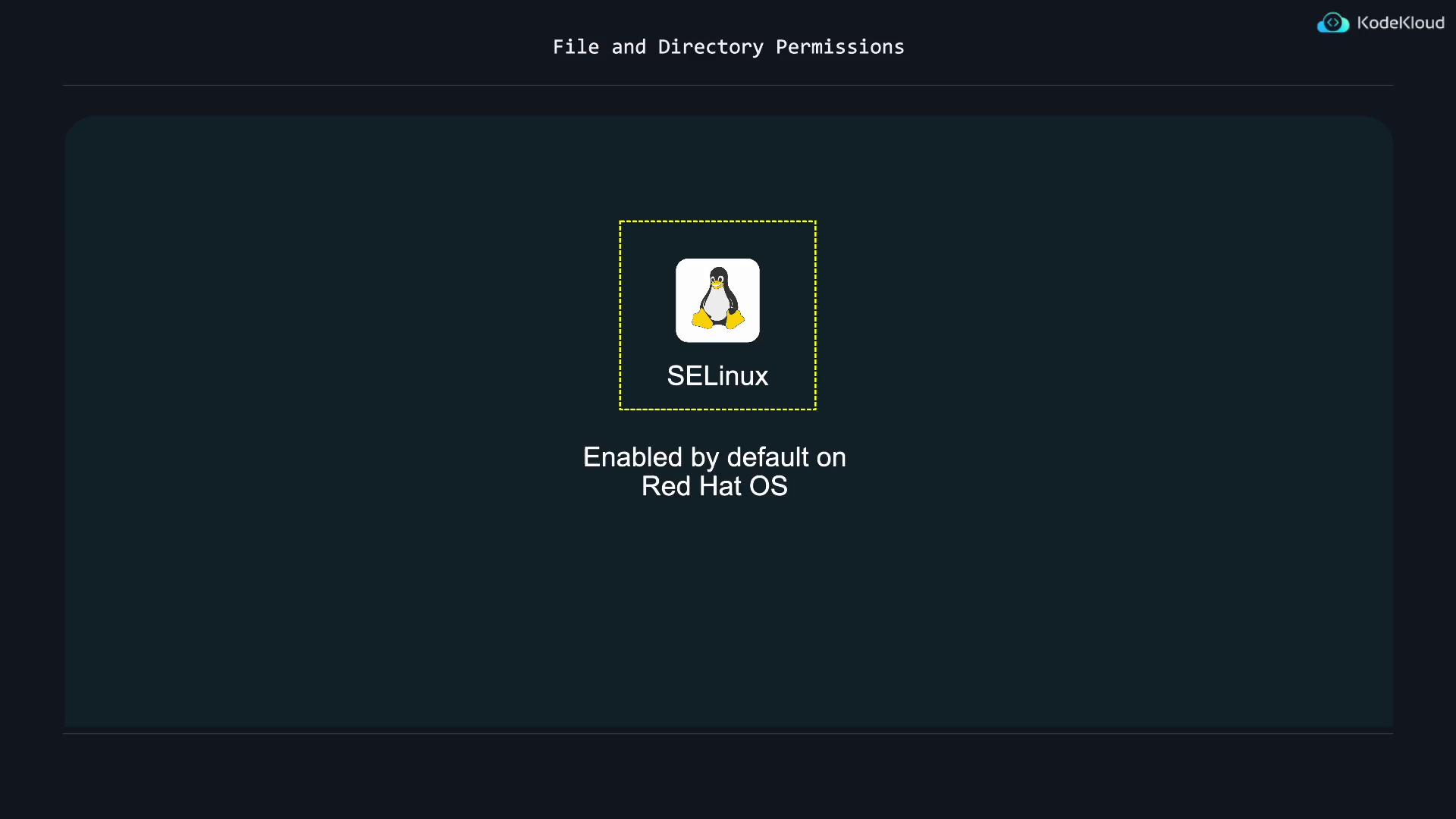Linux Foundation Certified System Administrator (LFCS)
Operations Deployment
List and Identify SELinux File and Process Contexts
In this lesson, we explore how SELinux applies security contexts to both files and processes. Traditional Linux access controls such as file permissions and directory settings are often too coarse to handle sophisticated cyber threats. Although these basic permissions allow read, write, or execute actions, they typically do not enforce fine-grained restrictions. SELinux bridges this gap by introducing advanced security contexts that enable highly granular access control.
Note
SELinux is enabled by default on Red Hat-based operating systems, whereas it requires manual configuration on Ubuntu. We will discuss Ubuntu SELinux configuration in a future lesson.

How SELinux Works at a High Level
At its core, SELinux uses security contexts—extended metadata labels on files and processes—to determine which actions are permitted or denied. A typical SELinux file label includes four components in the following order:
- SELinux User (e.g.,
unconfined_u) - Role (e.g.,
object_r) - Type (e.g.,
user_home_t) - Level (e.g.,
s0)
For example, the context label:
unconfined_u:object_r:user_home_t:s0
indicates that the file is associated with the SELinux user unconfined_u, the role object_r, the type or domain user_home_t, and the security level s0.
SELinux’s decision-making process follows these steps:
- User Mapping: The system first checks the SELinux user, which may be different from the Linux login username. Each login is mapped to an SELinux user as specified by the policy.
- Role Verification: The system then determines if the user has the necessary permissions to assume a specific role. For example, a developer may be confined to using roles such as
developer_rordocker_r, while roles likesysadmin_rremain off limits. - Type-Based Access Control: The type component enforces the most granular security. When processes or files are assigned a specific type, they are confined to a strict set of permitted actions.
- Security Level: Although rarely used in standard configurations, the level field enables multi-level security controls for organizations with multiple clearance layers.
Viewing SELinux File Labels
While the ls -l command displays standard file permissions, SELinux adds an extra layer of metadata referred to as a security context or label. To view these additional details, use the -Z option:
$ ls -lZ
-rw-rw-r--. 1 aaron aaron 160 Dec 1 18:19 archive.tar.gz
In this output, the extra field represents the SELinux context. This label at the filesystem level enables SELinux to determine which actions are permitted or denied on the file.
SELinux Process Contexts
Just as files receive security contexts, processes are also assigned SELinux contexts. To view process contexts, use the ps command with the -Z option:
$ ps axZ
system_u:system_r:accountsd_t:s0 995 ? Ssl 0:00 /usr/libexec/accounts-daemon
system_u:system_r:NetworkManager_t:s0 1024 ? Ssl 0:00 /usr/sbin/NetworkManager
system_u:system_r:sshd_t:s0-s0:c0.c1023 1030 ? Ss 0:00 /usr/sbin/sshd -D -
system_u:system_r:tuned_t:s0 1032 ? Ssl 0:00 /usr/libexec/platform-tuned
system_u:system_r:cupsd_t:s0-s0:c0.c1023 1033 ? Ss 0:00 /usr/sbin/cupsd -l
In the example above, notice that the SSH daemon operates within the sshd_t domain. Only executables labeled with sshd_exec_t (the type for the SSH daemon file) can run in this domain. To verify the SSH daemon file’s SELinux context, run:
$ ls -Z /usr/sbin/sshd
system_u:object_r:sshd_exec_t:s0 /usr/sbin/sshd
This strict relationship between file types and process domains ensures that if a process becomes compromised, it remains confined within its limited security domain, thereby minimizing potential damage.
SELinux User Context and Role Mapping
SELinux assigns a security context to each user session. Upon login, a Linux user is mapped to an SELinux user. You can view your current SELinux user context with:
$ id -Z
unconfined_u:unconfined_r:unconfined_t:s0-s0:c0.c1023
Here, the logged-in user is mapped to unconfined_u along with an associated role and type that impose minimal restrictions by default. Most access control decisions are enforced by the role and type components. For further insight into user-to-role mappings, you can list the allowed logins and SELinux user configurations:
$ sudo semanage login -l
Login Name SELinux User MLS/MCS Range Service
__default__ unconfined_u s0-s0:c0.c1023 *
root unconfined_u s0-s0:c0.c1023 *
$ sudo semanage user -l
Labeling MLS/Prefix MLS/MCS Level MCS Range
root sysadm s0 s0-s0:c0.c1023
staff_u staff s0 s0-s0:c0.c1023
sysadm_u sysadm s0 s0-s0:c0.c1023
system_u user s0 s0-s0:c0.c1023
unconfined_u unconfined s0 s0-s0:c0.c1023
user_u user s0 s0-s0:c0.c1023
These commands provide a clear view of how Linux logins are mapped to SELinux users along with their permitted roles and clearance levels.
Checking SELinux Enforcement Status
To determine whether SELinux is actively enforcing policies, use the following command:
$ getenforce
Enforcing
If the output is "Enforcing," SELinux is actively blocking unauthorized actions. If the output shows "Permissive," SELinux logs actions that would be denied but does not block them. A status of "Disabled" indicates that SELinux is currently inactive.
Summary
In summary, SELinux uses multi-layered security contexts—composed of user, role, type, and level—to enforce strict access controls on both files and processes. Even if a process is compromised, these stringent policies confine it to a safe security domain, significantly reducing potential system damage.
Watch Video
Watch video content